
Final Fantasy Tactics is a tactical role-playing video game developed and published by Square for the PlayStation video game console. Released in Japan in June 1997 and in the United States in January 1998 by Sony Computer Entertainment, it is the first game of the Tactics series within the Final Fantasy franchise, and the first entry set in the fictional world later known as Ivalice. The story follows Ramza Beoulve, a highborn cadet placed in the middle of a military conflict known as The Lion War, where two opposing noble factions are coveting the throne of the kingdom.
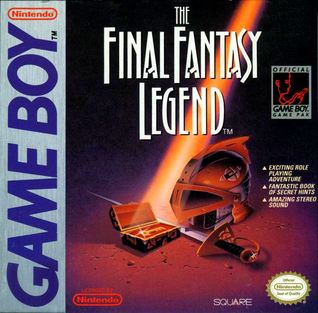
The Final Fantasy Legend, originally released in Japan as Makai Toushi Sa・Ga is a role-playing video game developed and published by Square for the Game Boy. It was originally released in Japan in December 1989 and North America in September 1990. It is the first game in the SaGa series and the first role-playing video game for the system. Square translated the game into English for worldwide release and renamed it, linking it with the Final Fantasy series to improve marketing. Sunsoft re-released it in North America during 1998; Square followed with a Japan-exclusive remake released for the WonderSwan Color and mobile phones in 2002 and 2007 respectively, it was also ported to the Nintendo Switch in 2020 and later ported to Android, iOS and Microsoft Windows in 2021.

SaGa (サガ) is a series of science fantasy role-playing video games by Square Enix. The series originated on the Game Boy in 1989 as the creation of Akitoshi Kawazu at Square. It has since continued across multiple platforms, from the Super NES to the PlayStation 2. The series is notable for its emphasis on open world exploration, non-linear branching plots, and occasionally unconventional gameplay. This distinguishes the games from most of Square's other franchises.

Final Fantasy Crystal Chronicles is an action role-playing video game developed by The Game Designers Studio and published by Nintendo for the GameCube. It was released in 2003 in Japan and 2004 in North America, Europe and Australia. A remastered version for Nintendo Switch, PlayStation 4, Android, and iOS was released in August 2020. A spin-off of the Final Fantasy series and beginning of the series of the same name, Crystal Chronicles was the first title in the franchise to be released for a Nintendo home console since Final Fantasy VI in 1994.
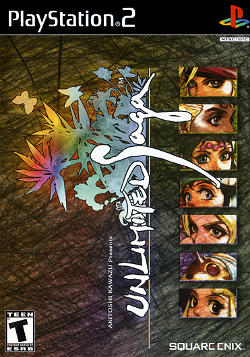
Unlimited Saga is a 2002 role-playing video game developed and published by Square for the PlayStation 2 as the ninth game in the SaGa series. It was released in 2002 in Japan and 2003 in North America and Europe; its European version was published by Atari Europe. The story follows seven characters as they explore mysteries connected to the Seven Wonders, artifacts left by an ancient civilization said to be capable of triggering a golden age. Battles carry over the skill-based levelling systems and nonlinear structure of earlier SaGa titles, with an exploration structure similar to a board game.

SaGa Frontier 2 is a role-playing video game developed and published by Square for the PlayStation. It is the eighth original game in their SaGa series. Initially released in Japan in April 1999, an English version was made available in North America in February 2000 by Square Electronic Arts and in PAL regions the following March by Square. Development for the title was headed by series creator Akitoshi Kawazu, with music by Masashi Hamauzu. The game features an art style unique to the series at the time it was released, utilizing hand-painted watercolor backdrops and characters to give the game a storybook feel. Like other SaGa games, gameplay is largely non-linear, giving the player multiple paths to follow in order to complete the game.
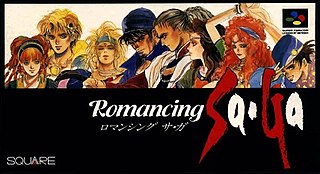
Romancing SaGa is a 1992 role-playing video game developed and published by Square for the Super Famicom. It is the fourth entry in the SaGa series. It was subsequently released for the WonderSwan Color in 2001 and mobile phones in 2009. A remake for the PlayStation 2, subtitled Minstrel Song in Japan, was released in both Japan and North America in 2005 by Square Enix. A remaster of Minstrel Song was released worldwide in 2022 for Android, iOS, Nintendo Switch, PlayStation 4, PlayStation 5 and Windows.

Final Fantasy Legend II, known in Japan as SaGa 2: Hihou Densetsu, is a role-playing video game developed and published by Square for the Game Boy. The second entry in the SaGa series, it was released in 1990 in Japan, and in 1991 in North America. A remake for the Nintendo DS was released in 2009 by Square Enix, remaining exclusive to Japan. The Game Boy version was later ported to the Nintendo Switch and released worldwide by Square Enix in 2020, with later ports to Android, iOS and Microsoft Windows in 2021.

Final Fantasy Legend III, known in Japan as SaGa 3: Jikuu no Hasha, is a role-playing video game developed and published by Square for the Game Boy. The third entry in the SaGa series, it was released in Japan in 1991 and in North America in 1993. A remake for the Nintendo DS was released in 2011 by Square Enix, remaining exclusive to Japan. The Game Boy version was later ported to the Nintendo Switch and released worldwide by Square Enix in 2020, with later ports to Android, iOS and Microsoft Windows in 2021.

Akitoshi Kawazu is a Japanese game designer, director, producer and writer. After joining Square in 1985, he went on to become a central developer for the first two Final Fantasy titles, then acted as creator and lead developer for the SaGa series.

Romancing SaGa 3 is a 1995 role-playing video game developed and published by Square for the Super Famicom. The sixth entry in the SaGa series, it was also the last developed for the platform. Originally released on the Super Famicom system in Japan on November 11, 1995, the game was released on the Virtual Console in Japan for Wii on September 21, 2010 and Wii U on February 26, 2014.

Romancing SaGa 2 is a 1993 role-playing video game developed and published by Square for the Super Famicom. It is the fifth entry in the SaGa series. It received an expanded port for Japanese mobile devices from Square Enix in 2011. This version was remastered by ArtePiazza and released worldwide between 2016 and 2017 by Square Enix for Android, iOS, PlayStation Vita, Nintendo Switch, PlayStation 4, Windows and Xbox One.
SaGa is a series of science fiction role-playing video games produced by Square, now Square Enix. The series originated on the Game Boy in 1989 as the creation of Akitoshi Kawazu. It has since continued across multiple platforms, from the Super Nintendo Entertainment System to the PlayStation 2, and like the Final Fantasy series, the story in each SaGa game is independent of its counterparts. The music of the SaGa series consists of musical scores and arranged albums from various composers. Some of these composers have created soundtracks and pieces for other Square Enix franchises including the Final Fantasy series and Mana series. The SaGa series is divided up between the original series, released as the Final Fantasy Legend series in North America, the Romancing SaGa series, the SaGa Frontier series, and Unlimited SaGa.
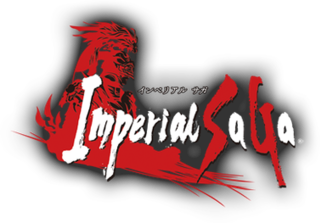
Imperial SaGa is a role-playing browser game developed by Think & Feel for web browsers. The eleventh installment in the SaGa series, the game was published by Square Enix in 2015. The service ceased in 2019. Designed as part of the series' 25th anniversary celebrations, it was developed with the supervision of series creator Akitoshi Kawazu.

SaGa: Scarlet Grace is a role-playing video game co-developed by Square Enix and Studio Reel. The twelfth entry in the SaGa series, the game was published by Square Enix in 2016 for the PlayStation Vita. An expanded port subtitled Ambitions was released in 2018 in Japan and in 2019 worldwide for Android, iOS, Nintendo Switch, PlayStation 4 and Windows. The story follows four characters pursuing separate missions across the splintered remains of a dissolved Empire; central to the plot is the Firebringer, a rebellious deity defeated during the Empire's height. Gameplay focuses on the protagonists exploring the nonlinear world, taking part in turn-based battles where skill growth depends on chosen actions.

Super Robot Taisen OG Saga: Endless Frontier Exceed is a crossover role-playing video game developed by Monolith Soft and published by Namco Bandai Games for the Nintendo DS (DS) in 2010. Forming part of the Super Robot Wars series, Endless Frontier Exceed is a sequel to the 2008 DS game Super Robot Taisen OG Saga: Endless Frontier, carrying over its gameplay elements.
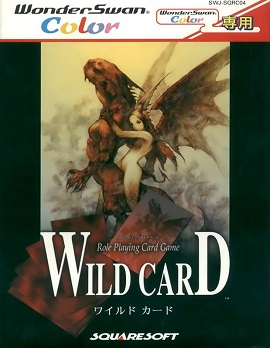
Wild Card is a 2001 role-playing video game developed and published by Square for the WonderSwan Color. It was Square's first original title for the platform. The player takes on the role of a protagonist going through a series of freely-available scenarios, building the world based on character interactions. The world, characters and turn-based battle system are represented using cards.

SaGa: Emerald Beyond is a 2024 role-playing video game developed and published by Square Enix. An entry in the SaGa series, it was released for Android, iOS, Nintendo Switch, PlayStation 4, PlayStation 5, and Windows. The story follows six protagonists as they traverse multiple worlds connected to a realm called the Beyond. The player explores these worlds completing quests and unlocking new events, with the turn-based combat focusing on timeline manipulation and skill growth dependant on in-game actions.

Asellus is a character in the 1997 video game SaGa Frontier, and one of its seven main characters. She is a human who became half-Mystic, a vampire-like race, after nearly dying after being struck by a carriage and saved by being given blood from a Mystic named Orlouge. Her design was created by character artist Tomomi Kobayashi, and her scenario was written by Miwa Shoda. Shoda was inspired to write a maiden game in a world of demons by multiple sources, including Takarazuka Revue, Otome games, and Shōjo manga, with Asellus' Mystic origins inspired by a dream with the same premise as Asellus'. Asellus speaks masculine when talking to women and feminine when talking to men.




















